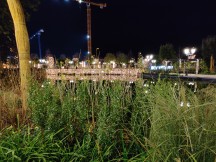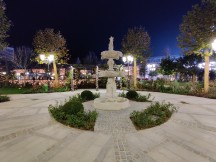OnePlus 7T long-term review

Performance, smoothness
Historically, at least over the past couple of years or so, OnePlus phones have always been performance champs, feeling very fast no matter what. That holds true of the 7T as well, not that anyone would be surprised. Subjectively, it feels like the fastest phone on the market right now, and that's an assessment you won't be able to get from cold, dry benchmarking numbers. It flies no matter what you throw at it, and it never gets uncomfortably hot even in very demanding use cases.
We've had no stutters or lags whatsoever, not even of the 'micro' variety. With the latest software version at the time of writing (that's OxygenOS 10.0.6), we've seen no bugs either (although a bunch were present in earlier iterations of the skin). The 7T is fast and feels very clean in use, with no unnecessary cruft. That's how the software looks, that's how it performs.

Smoothness is helped tremendously by the 90Hz refresh rate of the display. Even without this, OnePlus phones have been among the smoothest feeling in the business, but now the 7T really takes the crown (alongside the 7T Pro and the 7 Pro, in fairness). It's the smoothest handset we've ever used for a long-term review, by a long shot. If that's what primarily matters to you in a smartphone, then this is the one for you right now.
Battery life
Battery life hasn't been record-breaking for us on the 7T, but we were expecting that based on two very obvious factors: the 3,800 mAh cell which is on the small side compared to what we're used to getting these days, and the 90Hz refresh rate of the display. Note that we've had this enabled at all times while using the phone - not forced 90Hz, but the option in Display settings that automatically switches to 60Hz when it's appropriate (there are no 90fps videos on YouTube for example).
So with that in mind, and with our normal use case for long-term reviews, we've always achieved more than 5 hours of screen on time in a 12-16 hour day off the charger. Sometimes not much more, and then a few other times we've broken past 6 hours.
Again, that is perfectly decent battery life, but nothing to shout about in awe. It's probably time for OnePlus to up its battery capacity game next year, because most of its competitors have at least matched, if not surpassed it by now. The use case for the long-term reviews involves mostly Wi-Fi connectivity, with an hour or two on 4G data, Bluetooth always on and an hour or so of music streaming, an hour or two of phone calls, around half an hour of GPS navigation, and location always on (with Wi-Fi and Bluetooth scanning too).
Camera
The OnePlus 7T ups its camera game significantly compared to the OnePlus 7 and 6T before that, now sporting three actually useful rear shooters, going with the setup that's starting to become the norm in the mobile world (somebody please tell Google): normal, ultrawide, telephoto.

The 7T has each of these, although the zoom cam isn't as zoomy as the one in the Pro model. It still achieves 2x, which is nothing to scoff at. Since that has a 51mm focal length and the ultrawide sits at 17mm, in some ways you can say that the 7T has a 3x range between its shooters, which is neat and allows you a lot of flexibility when it comes to framing your shots.
The main camera is still the same 48 MP as before, but the aperture is slightly brighter. This shooter produces daytime images with good dynamic range and accurate color reproduction (with the slightest hint of an added 'pop'). The level of detail isn't the best we've seen, but still passable. Noise reduction is rather aggressive, though. Fine textures are sometimes prone to get a bit smeared when you look in up close.
























Daytime samples from the main sensor
Daytime zoom shots from the new 2x 12MP telephoto lens have good dynamic range and accurate colors like their counterparts from the main cam. While in most cases you get a similar look to the shots captured by these two snappers, sometimes things do tend to look different, in colors but also in dynamic range (depending on whether HDR fired or not). This issue is less present than with other devices, though. The zoom lens is good to have, but nothing to write home about, especially as pixel peeping can reveal artifacts left and right from antialiasing and interpolation.
























Daytime samples from the telephoto cam
For daytime shots, the ultrawide delivers that coveted greater field-of-view, even if you'll have to live with noise, lack of details, as well as the expected distortion around the edges.





















Daytime samples from the ultrawide
When the light goes down the main 48 MP camera shoots pictures that come out good, if not amazing, or among the best we've ever seen. The 7T can hold its own even at night, but really can't compete for the podium of best low-light smartphone cameras out there at this point. Noise reduction is understandably more aggressive than during the daytime, and details are softer. Dynamic range remains good, though, color rendition too.
























Nighttime samples from the main sensor
The new Nightscape mode helps restore highlights and bring up shadow details, controlling the dynamic range even better and just enhancing the overall exposure. That said, if you're trying to use it in conditions that are pitch dark, results won't be great, and definitely not on par with what Huawei's, Google's, and Apple's can achieve.






Nightscape shots from the main sensor
Nightscape also works on the ultrawide cam, so let's get to that. First, though, some samples sans Nightscape taken with that camera at night. As you may have expected, these aren't great. They're usually darker than what comes out of the main sensor, and mushier as well. Quality-wise they sort of remind us where the main cameras of a few years past used to be at when shooting in low-light conditions.
























Nighttime samples from the ultrawide
Nightscape does help make things more usable if you're going with the ultrawide, but as a general rule you should probably only pick this snapper if you have to, considering the necessary framing. The main sensor has a lot more to work with in order to create better overall shots.






Nightscape shots from the ultrawide
You can capture 2x images at night too, although there's no Nightscape available for this one. With some artificial light around, snaps can turn out decent, at least for social media use. But the moment the ambient light levels really go down, so does the quality, and you're left with soft and blurry images that are almost (if not entirely) unusable. So the rule of thumb at night is - only switch from the main sensor if you really have to.
Selfies are very detailed during daytime, if a bit soft. Color accuracy is good, including for skin tones, but sometimes harsh highlight transitions can be expected. Overall though, few people would complain about this selfie shooter.



Daytime selfies (Portrait Mode on the last one)
At night things understandably become worse, so as light levels go down around you, you should probably consider using the screen flash feature, which will light up the display really bright before capturing a shot. This will at least make your face visible in the picture. Portrait mode for selfies is available, but not perfect since it only has one camera to work with. Still, for a single-cam implementation it's pretty good.


Nighttime selfie samples, Portrait Mode off/on
Note that, as usual, all the camera samples we took for this long-term review use the default settings, since that's how most people are going to end up using it anyway.
Camera app
The camera app itself is unsurprisingly similar to OnePlus' previous efforts in this space, with the swipey viewfinder and weirdly placed Settings icon (you need to swipe up the black area that hosts the shutter button in order to reach more options, among which that is one). The fact that you simply can't access camera settings when you just quickly double tap the power button to access the app is still quirky and annoying and present. You'll need to unlock the screen first.

That said, the shortcut does work very reliably, and actually that's the best way to describe the entire camera app experience. We've had zero crashes or lags or hangs, and have taken many hundreds of pictures with it during this long-term review process. It's fast although switching between rear shooters isn't instant, but we're sort of used to that from other phones. That switching could be faster, though, perhaps a future software update will do something about it.
One neat trick that the OnePlus camera app has up its sleeve compared to others is that you can personalize the shooting modes you see under the viewfinder, and their order as well. So no more digging for stuff that you use often - you can just set it so it's there, just one or two swipes away at all times.
Reader comments
- GenXtech
- 28 Mar 2024
- EH6
I have a OnePlus 7T with 8/128GB. I bought it in 2019. It still holds it's own against today's smartphones. The battery life is reduced, but still not bad. It still charges rapidly on warpcharge. The only downside is that it is a 4G phone. ...
- Anonymous
- 24 Sep 2022
- vI1
I would say after using for 3 years now, I have not seen such an amazing smartphone of that time. It still copup with today's flagships. Battery do shows now little fastter discharge but is manageable by the usage. This smartphone served it purp...
- Anonymous
- 20 Jun 2021
- YQR
Battery goes down too fastly.






















